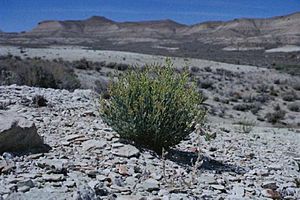Glaucocarpum facts for kids
Quick facts for kids Glaucocarpum |
|
|---|---|
 |
|
| Conservation status | |
| Scientific classification | |
| Kingdom: | |
| (unranked): | |
| (unranked): | |
| (unranked): | |
| Order: | |
| Family: | |
| Genus: |
Glaucocarpum
Rollins
|
| Species: |
G. suffrutescens
|
| Binomial name | |
| Glaucocarpum suffrutescens (Rollins) Rollins
|
|
| Synonyms | |
|
Hesperidanthus suffrutescens |
|
Glaucocarpum suffrutescens is a very rare flowering plant. It's also known by common names like Uinta Basin waxfruit or waxfruit mustard. This plant is part of the mustard family.
It grows only in Utah, United States, specifically in Duchesne and Uintah Counties. Because it's found in such a small area and is facing threats, the United States government has listed it as an endangered species. This means it's at risk of disappearing forever.
Contents
What Does It Look Like?
This plant is a perennial herb, which means it lives for more than two years. It has several stems that grow straight up, reaching about 10 to 35 centimeters (4 to 14 inches) tall. These stems grow from a woody base.
Its leaves are shaped like a spear or a bit like an oval. They can be up to 2.5 centimeters (1 inch) long. The edges of the leaves are usually smooth, but sometimes they have tiny teeth.
Flowers and Fruit
The flowers grow in a cluster called a raceme, which is like a stalk with flowers along its sides. These flowers look similar to other mustard plants. Each flower has four yellow petals, about a centimeter long, and yellow-green sepals (leaf-like parts that protect the bud).
After the flowers are pollinated, they produce a curved fruit called a silique. This fruit is 1 or 2 centimeters long.
How It Gets Pollinated
Different kinds of bees help pollinate this plant. This means the bees carry pollen from one flower to another, helping the plant make seeds. Some of the bees that likely help include Dialictus perdifficilis, D. sedi, Evylaeus pulveris, Andrena walleye, A. prunorum, and Halictus rubicundus.
Where Does It Live?
The Uinta Basin waxfruit grows in a special area called the Uinta Basin in Utah. It prefers to grow on a rock layer known as the Green River Formation. This area is right on the border between Duchesne and Uintah Counties.
The soil where it grows is quite unique. It's a thin layer of dry, fine clay and white calcareous shale. Calcareous means it contains a lot of calcium carbonate, which is like the material in chalk or seashells.
This plant lives in a plant community that is either a desert shrubland or a pinyon-juniper woodland. These areas don't have many plants growing close together. Sometimes, another rare plant called Barneby's catseye (Cryptantha barnebyi) can be found nearby.
How Many Plants Are There?
Scientists have found seven groups, or "populations," of this plant. These populations are located in three main areas. Sadly, five out of these seven populations have 250 plants or fewer. This shows how truly rare the Uinta Basin waxfruit is.
Why Is It Endangered?
The Uinta Basin waxfruit faces many threats that put its survival at risk.
Energy Development
One of the biggest threats comes from exploring for and mining oil shale and tar sands. All the places where this plant grows are on land that has been rented out for oil and gas exploration. The plant's habitat is located over a large amount of oil shale, which could be mined in the future.
When the plant was first added to the Endangered Species List, some parts of its populations had already been destroyed because of energy development activities.
Habitat Loss and Other Threats
The different groups of plants are already separated from each other, which is called habitat fragmentation. This separation gets worse when new roads are built through the area. Dust from these roads and from energy activities can also harm the plant.
Some of the things that hurt the plant's home also affect the bees that pollinate it. Other dangers include people driving off-road vehicles, animals grazing (eating plants), and mining surface rock to use for building materials.
See also
 In Spanish: Glaucocarpum suffrutescens para niños
In Spanish: Glaucocarpum suffrutescens para niños


